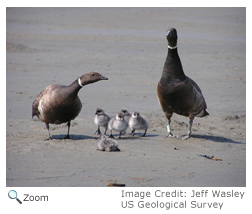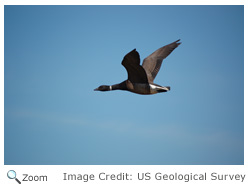Life Cycle

Brants arrive at their breeding grounds already paired off in early June. Brants nest in colonies in lowland areas of the tundra and prefer small islets in ponds and small lakes.
Female brants lay three to five eggs in a nest of moss, lichen, seaweed, and down in a depression in the ground. When the female leaves the nest to forage, she will cover the eggs with down to keep them warm.
The eggs take a little under a month to hatch. The chicks will leave the nest and are led to forage for food within a few days. The chicks will fledge in 40-50 days, but they will stay with their parents through the winter. Brant pairs will usually remain together and return to the same breeding ground year-after-year.
Behavior

Brants are long distance migrators. Some fly 3,000 miles from their nesting grounds on the coast of Arctic Ocean to the coast of Mexico. Other groups migrate from the Arctic down the Hudson Bay to the Atlantic Coast.
Brants don't migrate in V's like Canada geese or straight lines like snow geese. They fly in unorganized groups. They are very vocal when they migrate and make a loud "
cronk" sound.